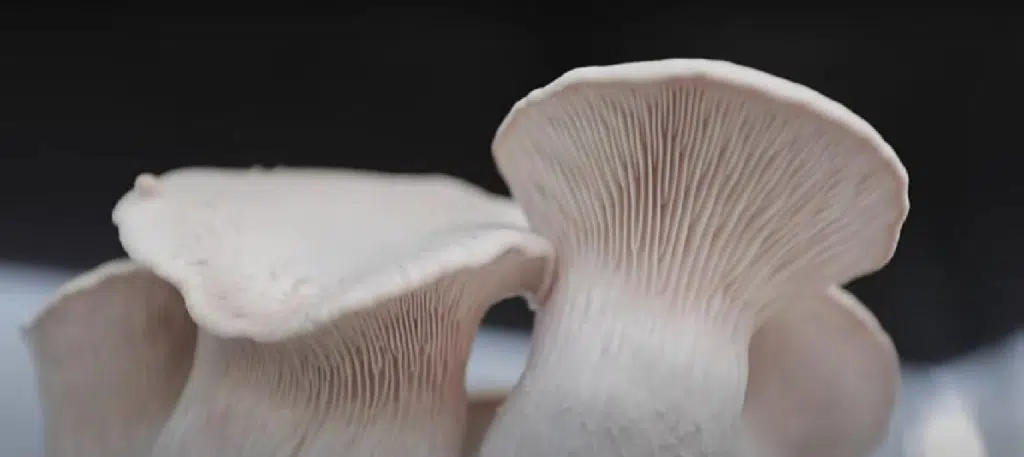King oysters are a favorite with mushroom farmers and chefs, because they’re relatively easy to grow, large and meaty, and versatile in the kitchen.
These in-demand mushrooms are part of the same genus or family, Pleurotus, as other oyster mushrooms, but not the same species.
Unlike side-fruiting oyster mushrooms (Pleurotus ostreatus) that grow in clusters, king oysters (Pleurotus eryngii) are top-fruiting and develop individually.
Perhaps you’re wondering how to grow king oyster mushrooms at home?
The good news is you have several options and don’t need expensive equipment to start.
Read on to learn different ways to grow king oyster mushrooms, what you’ll need, how long it takes and how to grow king oyster mushrooms indoors and outdoors step-by-step.

Why Should You Grow King Oyster Mushrooms?
King oyster mushrooms are versatile, gourmet mushrooms sought after by chefs for their thick, meaty stems that make a great meat substitute.
You’ll sometimes find king oyster mushrooms at grocery stores, alone or as part of gourmet mushroom mixes for their meaty texture and unique flavor profile.
They have several names, and stores sell them as eryngii, king trumpet, royal trumpet, French horn, king oyster or scallop mushrooms.
However, depending on your location, they may not always be available, and the best way to have an ongoing supply of fresh king oyster mushrooms is to grow your own at home.
They’re a bit more complicated to grow than other oyster mushroom varieties as they’re sensitive to changes in humidity and temperature.
But, you can have fun experimenting with growing conditions and produce king oysters of different shapes and sizes as growing conditions impact their appearance.
Once you have a little experience growing king oyster mushrooms, you could start a small business and sell fresh king oyster mushrooms to upmarket restaurants in your area.
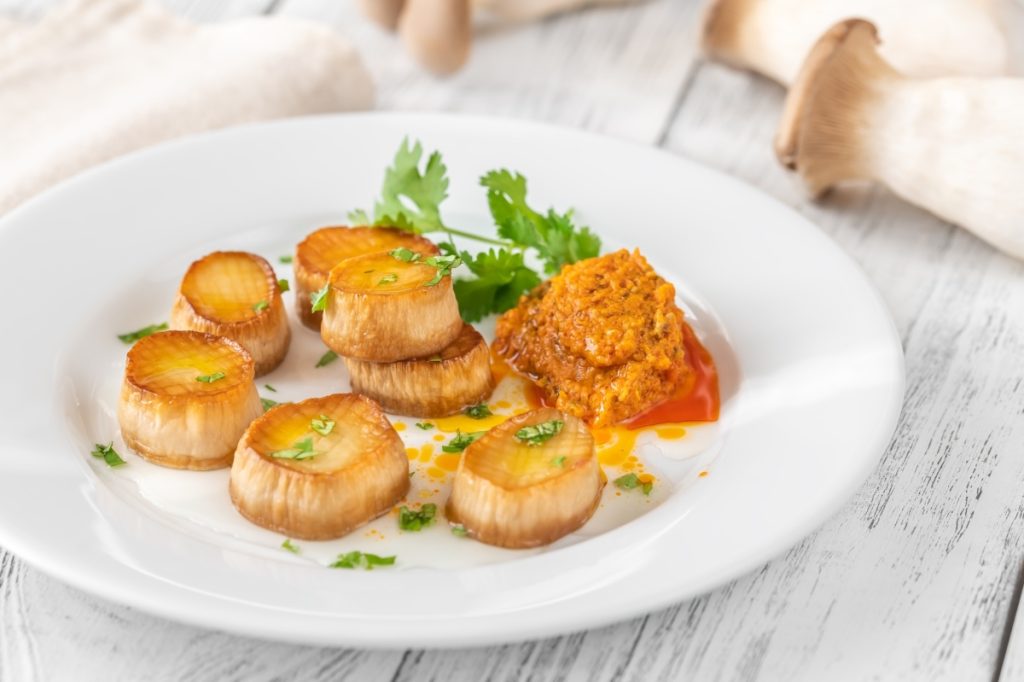
Different Ways to Grow King Oyster Mushrooms
There are several ways to grow king oyster mushrooms at home. Which is best depends on your previous experience and how many mushrooms you want to grow.
Here are some methods to consider:
King Oyster Mushroom Growing Kit
Mushroom grow kits are an ideal way for beginner mushroom growers to get their first taste of success.
King oyster grow kits usually contain a bag of fully colonized substrate ready for fruiting and allows beginners to focus on getting the fruiting stage correct and successfully harvesting king oyster mushrooms.
Grow Bags Indoors
Mushroom growing bags are the most popular way to grow king oyster mushrooms indoors, and most cultivators recommend them.
These bags have features that make the mushroom growing process easier and are suitable for most mushroom species, including king oysters.
The best bags to use for sawdust substrates are autoclavable bags that can withstand the high temperature required for sterilization.
Most mushroom-growing bags come with filter patches or collars and plugs, allowing the mycelium to breathe during colonization.
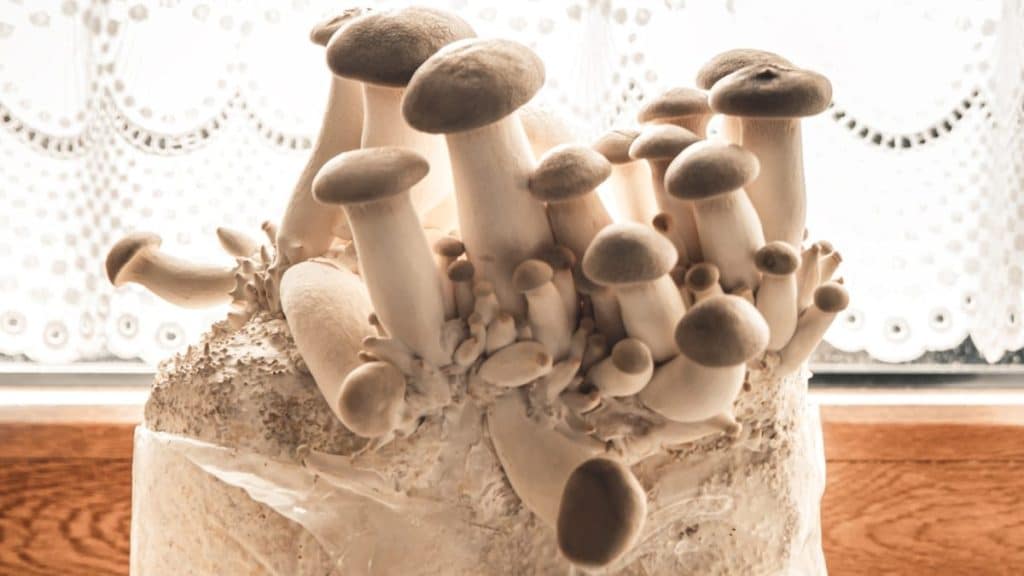
Autoclavable Bottles
King oyster mushrooms are a top fruiting species, meaning you can grow them in bottles.
This method is popular with large commercial cultivators but not as popular with home growers.
To learn more about growing mushrooms in bottles, have a look at our beginner’s guide to growing mushrooms in bottles.
Mushroom Beds Outdoors
If the climate in your area is suitable, you can also grow king oyster mushrooms outdoors in a mushroom bed.
You don’t need much space for an outdoor mushroom bed, but it should be in a shady, sheltered spot.
One of the only downsides to growing king oysters outdoors are the bugs and other critters that enjoy mushrooms as much as you do.
Depending on your location, you may need to cover the bed with a hoop screen to help prevent fungus gnats from getting to your mushrooms.
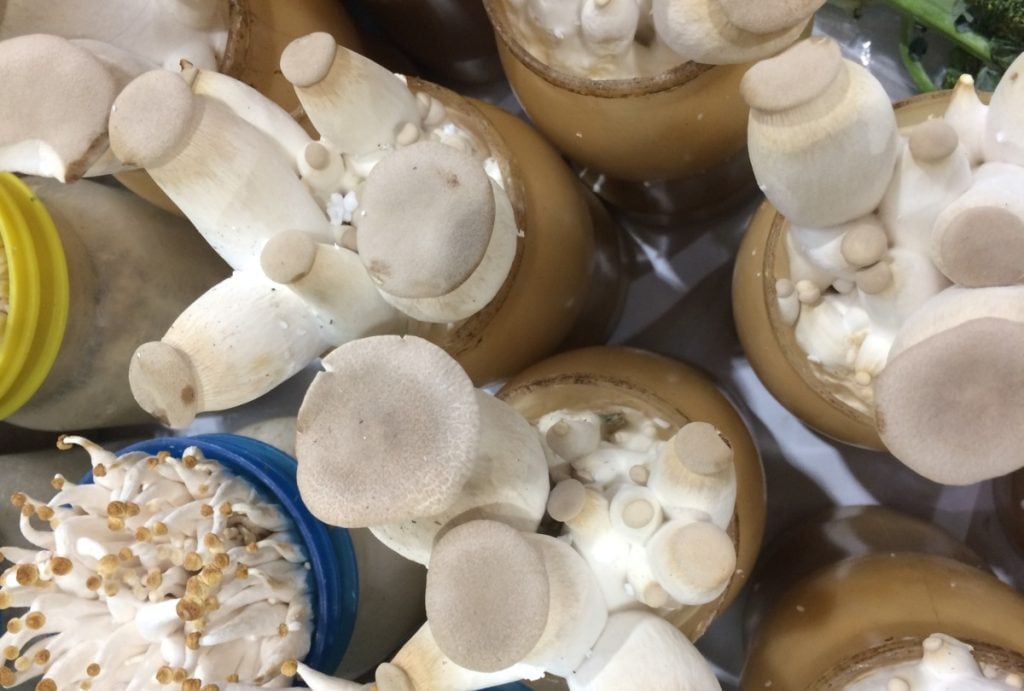
Supplies Needed to Grow King Oyster Mushrooms
You don’t need lots of expensive equipment to grow king oyster mushrooms. Apart from some everyday household items, you’ll need to source the following:
King Oyster Spawn
Always source your king oyster mushroom spawn from a reputable supplier, and for the best chance of success, buy spawn cloned from a proven strain.
Mushroom spawn consists of living mushroom mycelium grown into a nutritious substrate, usually grain or sawdust, to make it easy to transfer to another substrate.
Grain spawn is the best option when growing mushrooms indoors in bags, as it’s very nutritious and easy to distribute evenly through your bulk substrate.
For outdoor cultivation, sawdust spawn is a better choice, as birds and rodents may consume grain spawn before the mycelium can colonize your mushroom bed.
Substrate Material
Like other oyster mushrooms, king oysters will grow on several substrates, including coffee grounds, straw and agricultural waste products like cottonseed hulls, soybean hulls and corn cobs.
What is the best substrate for king oyster mushrooms?
For the best results, growers recommend a king oyster mushroom substrate of hardwood sawdust supplemented with 10 to 15% wheat or rice bran.
You will get better yields from a supplemented sawdust substrate, and the extra nutrients it provides reportedly produce mushrooms with a better texture and longer shelf life.
Growing Containers
You can grow king oyster mushrooms in various containers, including jars, bottles, buckets and bags.
Commercial growers usually use autoclavable mushroom grow bags or bottles when using sawdust substrates and rolls of poly tubing for straw.
As king oysters are a top fruiting species, hobby growers often grow them in Monotubs with great success.
We recommend growing them in large grow bags with some space above the substrate, as these allow you to create a high CO2 environment to encourage thick stems and small caps.

How Long Does it Take to Grow King Oyster Mushrooms?
If you’re using a king oyster growing kit, you could have ready-to-harvest king oyster mushrooms within 14 days of placing your kit in growing conditions.
Small mushroom pins should start forming on the surface of the substrate 4 to 8 days after opening the kit, and they’ll double in size daily from there.
If you’re preparing and inoculating organic material to make a fruiting block, allow another 14 to 21 days for the king oyster mushroom mycelium to colonize your bulk substrate.
Our article, “How Long Does It Take To Grow Mushrooms? All Questions Answered,” has more information on the timing for the different stages of mushroom growth.

How to Grow King Oyster Mushrooms Indoors
Follow the steps below to grow king oyster mushrooms indoors using mushroom grow bags.
Step1: Gather Supplies
The first step of gathering supplies is to research what sawdust substrate is readily available in your area and find a reputable spawn supplier.
If possible, chat with other mushroom growers in your area, as they may have information on which local suppliers are best.
Using this information, you’ll need to buy king oyster grain spawn, hardwood sawdust or pellets and mushroom grow bags.
When deciding what size grow bags to order, it’s important to remember that they’ll need to fit inside your pressure cooker when filled with substrate.
While waiting for these items to arrive, ensure you have all the equipment to prepare your substrate.
One of the benefits of growing mushrooms the “low-tech way” is that you don’t need expensive equipment, and you’ll probably already have many of these items.
You’ll need the following:
- Measuring cup
- Scale
- A bucket or tote for mixing the substrate
- Pressure cooker for sterilizing the substrate
Step 2: Prepare Substrate
Once you have all the supplies, you can begin.
First, you need to prepare your mushroom substrate. This step has three stages: mixing, hydrating and sterilizing.
1. Measure and Mix
First, measure out your dry substrate material and supplements and combine them in a plastic bucket or tote.
We recommend adding 10% wheat or rice bran to your hardwood sawdust to get the best king oyster yields possible.
2. Add Water
When growing mushrooms, you want to aim for a substrate evenly hydrated to 60 % or field capacity.
To achieve this, you’ll need to add water at a rate of around 1.5 to 1.7 times the weight of the dry substrate, depending on the particle size and type of sawdust you’re using.
To ensure the substrate is well mixed and evenly hydrated, it’s often best to mix it with your hands, but you can also use a spoon or sturdy plastic scoop.
A squeeze test is a quick and easy way to check that your substrate has the correct moisture levels.
Take a handful of your substrate mix and squeeze it lightly. Only a drop or two of water should come out of the substrate.
If more water is released, the substrate is too wet. If there are no drops and the substrate isn’t staying together in your hand, it’s too dry.
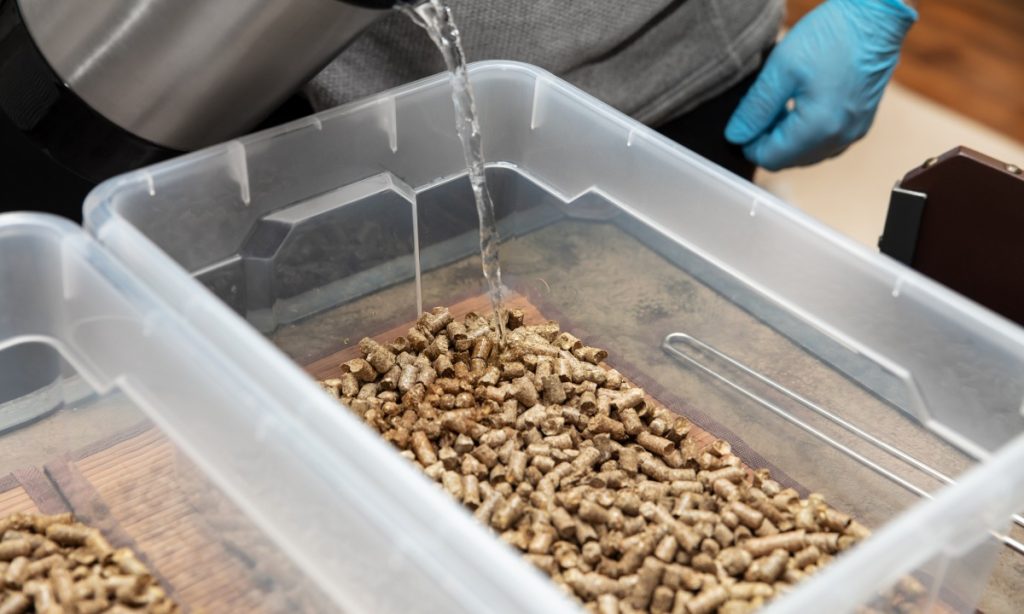
3. Sterilize
Once you are happy with the substrate’s moisture content, you can load it into your grow bags for sterilization.
You’ll need to use a rack to prevent your grow bags from touching the pressure cooker’s base and possibly burning.
It’s also important to leave space around each bag so they’re not touching the sides of the pressure cooker or other bags.
To eliminate all potential competitor organisms, sterilize the substrate for three hours at 15 PSI.
When the time’s up, you can turn off your pressure cooker and leave the bags inside until they have cooled to room temperature.
We recommend leaving them to cool for at least 8 hours.

Step 3: Inoculation
Once your bags have cooled to room temperature, you can add king oyster mushroom spawn.
This process is called “inoculation.” The recommended inoculation rate for king oyster grain spawn is 2 to 10% of the wet substrate weight.
The higher the inoculation rate, the quicker colonization will be.
It’s important to inoculate your bags in as sterile an environment as possible to prevent contaminants getting into your recently sterilized substrate.
First, wipe down your worktop and spawn bags or jars with alcohol, and clean your hands well with soap.
The best way to avoid contamination is to inoculate your substrate using a laminar flow hood.
But if you don’t have one, you can use a still air box or a clean, draft-free room and disinfectant spray to help reduce the number of airborne contaminants.
When the substrate and spawn are well mixed, tightly seal your bags with a rubber band or tie.

Step 4: Incubation
Now, the king oyster mycelium needs time to colonize the nutritious substrate you have provided.
This stage of the mushroom growing process is called incubation. During incubation, the mushroom mycelium will grow and spread throughout the substrate.
Place your king oyster bags in a dark, warm spot with temperatures between 70 – 75°F (21- 24°C) and leave them to incubate.
It should take around two weeks for the king oyster mycelium to colonize your substrate, but this will vary depending on your inoculation rate, substrate and conditions, and it could take up to three weeks.
When dense white mycelium has covered the substrate, colonization is complete, and you can move onto the fruiting stage.
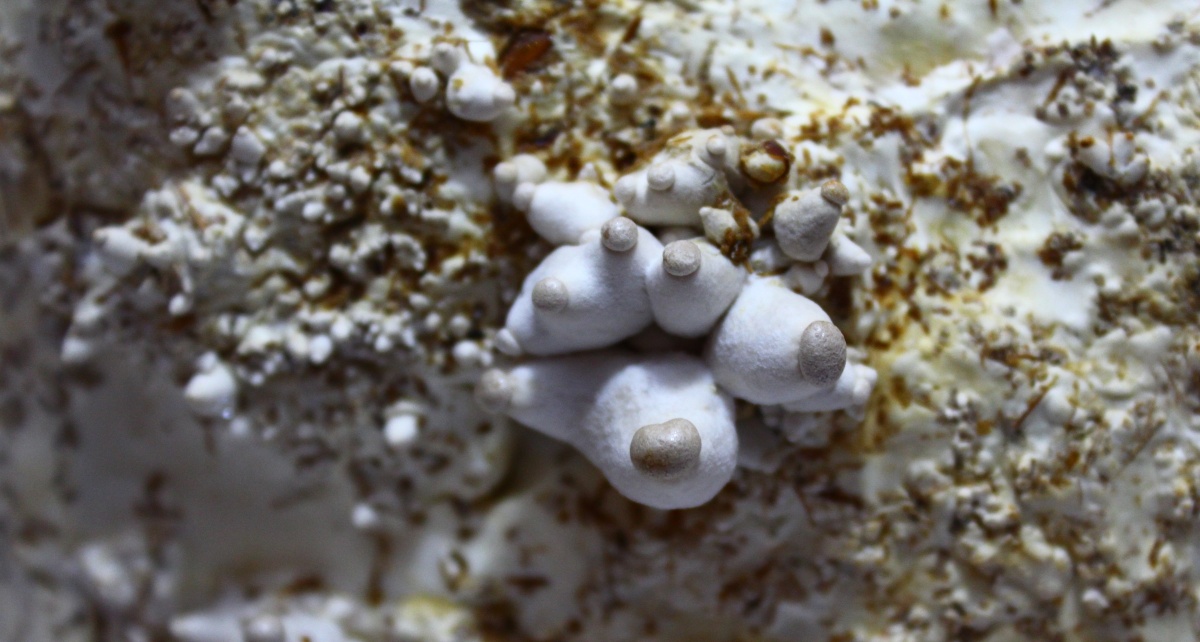
Step 5: Fruiting
Fruiting is the exciting stage of mushroom growing, where you finally see your mushrooms grow.
One of the things that makes king oysters slightly more challenging to grow than other oyster mushrooms is that their pins are sensitive to changes in humidity levels.
So, it’s crucial to maintain consistently high humidity levels during the initial stages of fruiting.
Many growers recommend covering the substrate with a casing layer to help regulate and maintain humidity levels.
But, this creates a lot of extra work when you have many bags and increases the chances of contamination as you may introduce contaminants in the casing material.
Instead, small-scale mushroom farmers recommend cutting off a corner of the bag to increase fresh air while maintaining high humidity on the surface of the substrate.
You can then leave the pins to develop and grow in the bag until they are approximately 2 inches (5 cm) tall.
Once they reach this stage, cut the bag off in line with the top of the substrate to increase fresh air exchange and lower CO2 levels while maintaining 85 – 88% humidity levels.
From this point, it usually only takes four to five days until your king oysters are ready to harvest.
You could get two to three flushes of mushrooms from your substrate block, one to two weeks apart.
What are the conditions for king oyster mushrooms to grow?
To help initiate pinning, after you cut open the corner of your bag, reduce the temperatures in your fruiting chamber to around 59°F (15°C) and maintain humidity levels of 95 to 100%.
Once pinning is complete, reduce humidity to 85 to 88% and maintain temperatures between 54 and 65°F (12 and 18°C).
When growing king oysters, consistency is critical, as big swings in humidity levels or temperature can cause the mushrooms to abort and stop growing.
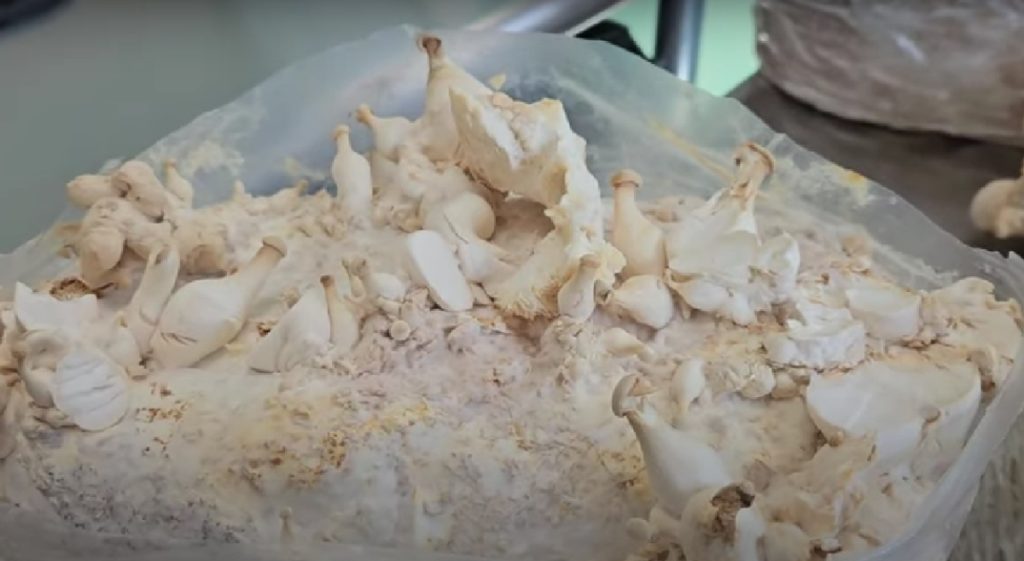
Step 6: Harvesting
You can harvest your king oyster mushrooms at any stage before the caps flatten out and they release their spores.
Younger mushrooms usually have a better flavor and texture, but king oysters are often left to mature until their stems are large enough to make “vegan scallops.”
It’s a bit of a balancing act to ensure you get the best yield possible while still harvesting them young enough to have the best possible flavor.
Generally, when it comes to oyster mushrooms, the best time to harvest them is when their caps have begun to flatten out, but the edges are still curled under.
The easiest way to harvest king oyster mushrooms is by gently twisting them off at the base without damaging the remaining mycelium.
How big do king oyster mushrooms get?
When grown in suitable conditions, a king oyster mushroom’s stem can get up to 8 inches (20 cm) long and 2 inches (5 cm) in diameter.

How to Grow King Oyster Mushrooms Outdoors
Growing king oysters in an outdoor mushroom bed is fun and does not need the same sterile conditions as indoor cultivation, but the results are less predictable, and the wait is longer.
Another thing to remember is that your outdoor king oyster mushrooms will look very different from those grown indoors.
When growing king oyster mushrooms outdoors, the mushrooms get lots of fresh air and indirect daylight, resulting in fruiting bodies with larger, darker caps and very short stems.
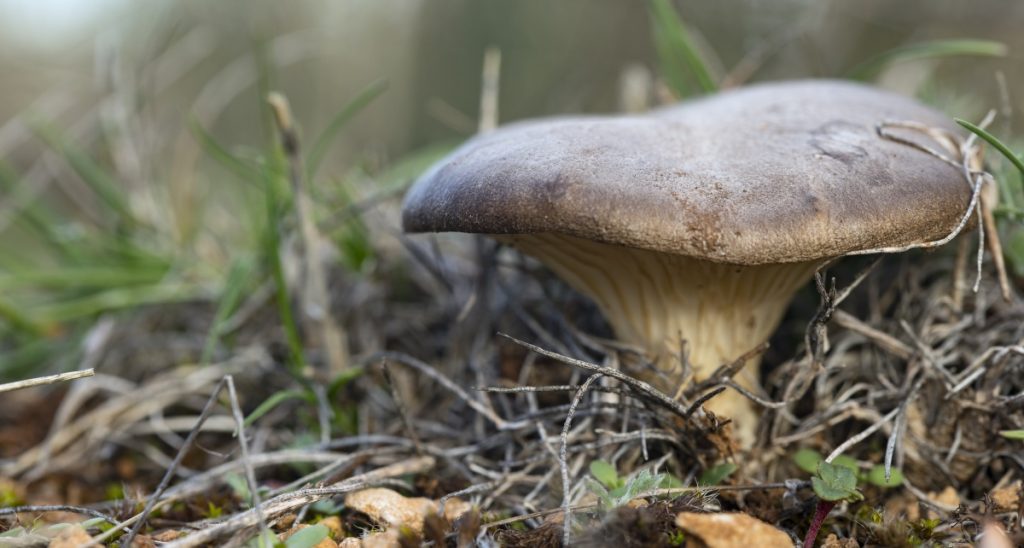
How do you grow king oyster mushrooms outside?
The best way to grow king oyster mushrooms outdoors is in a garden bed located in a shady spot, but you can also grow them in containers outdoors if you don’t have much space.
Follow the steps below to grow king oyster mushrooms outdoors in a garden bed.
Step 1: Gather Supplies
You don’t need much to grow king oysters outdoors. Just some king oyster mushroom spawn and organic material to use as a substrate.
We recommend using sawdust spawn to grow mushrooms outdoors, as birds, insects and rodents enjoy eating the grain used in grain spawn.
A mix of straw and wood chips makes the ideal substrate for king oysters in outdoor beds.
Step 2: Select a Suitable Spot
Choose a shady, sheltered spot for your mushroom bed that’s within easy reach for watering, as you’ll need to keep it moist.
The size of your bed will depend on space availability and the quantity of substrate and spawn you have.
The ideal depth for your mushroom bed is around 4 to 8 inches (10 to 20 cm), and there’s no point in making a large bed if you only have enough substrate and spawn to cover a small area.
It doesn’t matter how you choose to set up the edges of your king oyster mushroom bed as long as you create an area you can fill with wood chips and straw.
Placing a sheet of cardboard on the bottom of the bed can help prevent weeds from growing through your bed.

Step 3: Add Spawn and Substrate
Once your bed is ready, it’s time to add the wood chips, straw and spawn. The recommended inoculation rate is 5 to 10% of spawn to the wet weight of the substrate.
Layering is an easy way to inoculate mushroom beds. First, place a layer of wood chips at the base of your bed, then sprinkle half of your mushroom spawn over the wood chips.
Break up any clumps of spawn you come across and spread it evenly over the surface.
Then, add another layer of wood chips, the remainder of your spawn, and a final layer of wood chips on top. You want to sandwich your spawn between layers of wood chips.
Now, cover your bed with a thick layer of straw. The straw provides more substrate for the mycelium and helps retain water, preventing the bed from drying out.
The bed mustn’t dry out, so to help, some growers recommend covering it with a casing layer.
The casing could be a light layer of soil alone or a mixture of soil and coco coir to help with water retention.
Step 4: Maintain Moisture Levels
Once your bed is complete, the mycelium needs time to colonize the wood chips and straw. During this time, you’ll need to ensure the bed stays moist.
Your mushroom bed should not be waterlogged, but depending on the weather, it may need to be sprinkled with water daily or weekly to maintain humidity levels.
You may not need to water your mushroom bed if you live in an area with lots of rain.
Outdoor mushrooms will fruit when they have colonized the mushroom bed, and ideal weather conditions are present, usually in the fall.
So, depending on your climate and the time of year you created your bed, it could take six months to a year before it produces mushrooms.
King Oyster Mushroom Growing Issues
Like other varieties of oyster mushrooms, king oysters are relatively fast-growing and generally overcome contaminants during incubation.
However, a common issue with king oysters is they’re susceptible to bacterial blotch on the caps during the fruiting stage.
Bacterial blotch creates dark spots on the mushroom’s caps and is caused by excess humidity in the fruiting chamber, allowing water droplets to remain on the mushrooms for too long.
The solution is to have good airflow and air exchange through the fruiting chamber during the final stages of maturity.
Final Thoughts
King oyster mushrooms are one of the top five gourmet mushrooms we recommend small-scale mushroom farmers grow.
Although there are many delicious gourmet mushrooms, we considered factors such as yield, ease of growth and market demand when selecting our top five.
King oysters are sought after by chefs, provide high yields and are relatively easy to grow, although not as easy as other oyster mushrooms.
If you’re a complete beginner, we recommend starting with oyster mushrooms (Pleurotus ostreatus) and moving on to other species once you have some mushroom-growing experience.
To learn more about growing mushrooms at home or how to set up a low-tech mushroom farm, visit our Mushroom Growing Hub.
